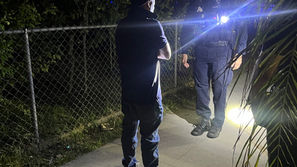La Vina farmers rescued Brown’s dream
- Bill Coate
- Jun 1, 2022
- 4 min read

For The Madera Tribune
John Brown is shown here in 1890. His farming colony near Madera evolved into what is now known as the La Vina District.
First came the miners and then the ranchers. They were followed by the lumbermen, and by the late 1800s, the farmers showed up. Within a few years, their family farms replaced the lumber flume as the economic base of Madera County.
The history of agriculture in this area is, in the main, a story of tremendous achievement, as immigrants and native-born alike moved to Madera to till the soil. Their efforts were crowned with success — with one notable exception — the John Brown Colony.
Brown was born in Warren County, Illinois, in 1860, and moved to Madera in 1889 to realize his vision of building a successful farming colony here.
So certain of success was Brown that he incorporated the “John Brown Colony” and purchased on credit 3,500 acres located 7 miles south of Madera from Thomas E. Hughes, the father of Fresno, and subdivided it into five-acre lots. Then he began to advertise the colony by flooding the East with promotional circulars, which promised potential colonists that he would sell them five acres of prime farm land for $300 if they wanted him to plant it in fruit trees before they got here; otherwise the price was $150.
All the buyer had to do was to make a small down payment as evidence of good faith and then make three annual payments on the balance. One third would be due at the end of the first year, another third at the end of the second year, and the balance at the end of the third year.
Interested parties were instructed to send their money to the treasurer of the Bank of Madera by bank draft. Personal checks were not accepted.
The response to Brown’s broadside advertisement was swift in coming, so he issued another missive and entitled it, “A Few Questions Answered.” In it Brown made the following claims about his colony.
• Our tract is from two to five miles from the railroad station.
• It is two to five miles from Madera and twenty from Fresno.
• Water rights are a part and parcel of the land and cannot be separated from it.
• Water for domestic use is found at from 50 to 75 feet (surface water at 10 feet) and is of the purest and best quality.
• The elevation above sea level is 300 feet.
• It is forty miles to the mountains and only 100 miles to the famous Yosemite Valley.
• The rainy season begins in October and ends in April. It does not rain all the time but as much as it does in the East during the summer.
• The climate is fine for consumptives if they come in time for it to help them. Rheumatism, Catarrh, and kindred troubles are usually helped.
• Fog is almost unknown here in the summer, and it only occurs in winter during damp weather during which times it will be foggy in any land.
• The sea breeze reaches us in the afternoon, blowing from the northwest.
• The soil of the land we offer is alluvial, deep and strong.
• Good oak wood is sold at six dollars a cord.
• Groceries and provisions are a little higher than in the East in some items. Flour and meat are about the same price.
• Wages for farm workers are $30 per month and board, the man furnishing his own blankets.
• There is less danger from earthquakes that there is in the East, and none at all from lightning, which is seldom seen.
• Strawberries can be had ten months out of twelve.
• Good teachers can always find a position. Teachers’ wages range from $60 to $125 per month.
• All attainable government land is of rugged nature, not capable of irrigation, far distant from business centers, and it would require more capital to settle on it than is required for settlement in close neighborhoods.
• Our land is entirely level, has no brush, trees nor stones upon it and is free from alkali.
• While at Washington and Philadelphia people fall dead in the streets with the thermometer at 90 degrees, in the San Joaquin Valley, the hay harvest is gathered in absolute safety with the thermometer at 110 degrees. The exceedingly dry temperature promotes rapid evaporation, which works this apparent wonder.
Lists of colonists and references to our reliability furnished upon request. Address the John Brown Colony, Madera California.
Flooding the East with circulars was not enough for Brown. In 1889 and 1890, he made several trips to Chicago in search of colonists, and they came in droves. Soon several settlers’ homes dotted the colony; they built a school, and a small town sprang up. In 1891, the United States government recognized the community by giving it a post office and calling it La Vina.
Everything was coming up roses for Brown and his colony until the agricultural depression of the 1890s. Commodity prices declined, and cash became scarce, consequently, many of the colonists could not make their payments to Brown. This, of course, meant that he could not meet the terms of his note to Hughes. By the mid 1890s, foreclosure followed, and the John Brown Colony collapsed. The La Vina post office was closed in 1895.
This did not mean, however, that agriculture died in the district. After the collapse of the John Brown Colony, a new wave of farmers came to the land, most of them Italians. They took up where John Brown left off, and today the land surrounding La Vina School continues to be some of Madera County’s most productive farmland — a fitting tribute to the man who first saw its possibilities.
























Comments